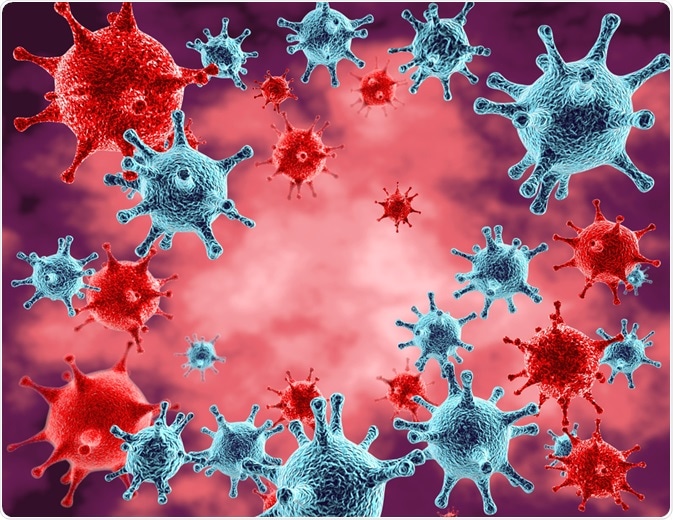Millions of people are globally affected by viral diseases. Viral diseases not only cause severe impact on human health but also to socio-economic developments.
Approved antiviral nanotherapeutics or nanomedicine under evaluation represents a fast-revolutionizing field that is making continuous progress.

Image Credit: Illustration Forest/Shutterstock.com
Which Factors Inhibit the Production of Novel Antiviral Drugs?
- The rapid development of drug resistance, especially those connected with HIV4–7 and influenza.
- Viruses multiply in host cells which, in turn, restrict the virus-specific metabolic sites that could be targeted by a particular antiviral agent without having any adverse effect on the host cell.
- Each virus has its own unique biosynthetic pathway. Therefore, the production of a generic drug that could target a wide range of viruses, is difficult.
Major Advantages of Nanomaterials in Antiviral Therapy:
- Nanoparticles have different shapes and morphologies
- Nanometric size allows drug delivery through impermeable barriers
- Large surface area to volume ratio is beneficial for large drug loads and improved efficacy
- Decreases the emergence of drug resistance
- Increased possibility of personalized therapy
Antiviral Nanotherapeutics
Nanomedicine
Several nanomedicines have already been approved, or are currently undergoing the approval process, to be used for the treatment of viral infections. Some of the potential nanotherapeutics under development are discussed below.
Human Immunodeficiency Virus (HIV):
The treatment is based on the usage of drugs that target the various stages in the life cycle of the virus. The current antiretroviral (ARV) armamentarium includes protease inhibitors, nucleoside/nucleotide reverse transcriptase inhibitors, non-nucleoside inhibitors, entry/fusion inhibitors, and integrase inhibitors.
Modern drug design involves the incorporation of the ARV drug with nanosystems, which decrease the dosage requirements and toxicity. This method of drug delivery improves the safety and efficacy profiles of the drug.
Hepatitis B Virus (HBV):
HBV is responsible for the inflammation and cirrhosis of the liver and can also cause liver cancer. This virus accounts for more than 700,000 deaths per year.
Current anti-HBV nano-therapy includes the use of pegylated IFN, lamivudine, adefovir, interferon (IFN)-α, etc.
Hepatitis C Virus (HCV):
The major complication of HCV includes liver cirrhosis and liver cancer. Significant HCV inhibition was reported using nanozymes. These nanozymes are extremely stable against enzymatic degradation and possess very low levels of toxicity.
Influenza:
Influenza is an immensely contagious respiratory disease. The genomic sequence of the influenza virus is capable of rapid mutations, thereby, giving rise to several novel strains. Nanotrap particles are thermo-responsive hydrogels.
These particles possess the property of entrapping viral RNA and viral proteins that cause the disease. This is indeed a very novel technology that can be utilized in the treatment of influenza.
Another method to treat influenza involves the use of liposomes and oseltamivir incorporated silver nanoparticles as drug delivery agents.
Herpes Simplex Virus (HSV):
HSV causes oral and facial lesions, encephalitis, genital infections, etc. In the treatment of HSV, promising results have been observed (including a reduction in the periodicity of drug administration) by the use of nanoparticles loaded with acyclovir.
Human Papillomavirus (HPV):
HPV primarily infects epithelial cells. HPV could result in common warts, cervical neoplasia, or cancer. Nano-based drugs incorporate siRNA for the treatment of HPV16 and HPV18.
These nanoparticle-based drugs express their antiviral potential through the E7 gene.
Human Parainfluenza Virus (HPIV):
This virus primarily infects human epithelial cells. The respiratory tract of infants and children are the primary targets of the disease caused by HPIV. Silver nanoparticles have recently been found to be effective against HPIV.
Ebola Virus Disease (EVD):
This virus is extremely deadly. It causes a highly infectious disease in humans and other primates. Treatment of EVD involves the usage of liposomes containing siRNA. Clinical trials have shown mixed results.
The drug did not show any effective results in patients in advanced stages of the disease. However, in milder cases, the drug showed promising results.

Image Credit: jaddingt/Shutterstock.com
Nanovaccines
Nanovaccinology follows both preventive and remedial approaches.
Advantages of Nanovaccines:
- Nanovaccines are superior to conventional vaccines in a number of ways. Conventional vaccines may require multiple administrations, be unstable, or may have weak immunogenicity. Nanovaccines help overcome such shortcomings.
- Nanovaccines do not need to be transported in cold chambers as they can be lyophilized. The shelf life of nanovaccines is also significantly greater than conventional vaccines.
- Given the small size of nanovaccines (similar to bacteria and viruses), it is readily identified by the human immune system.
Examples of Nanovaccines:
Hepatitis A Virus (HAV) is mostly associated with food-borne infections. A lipid-based nanosystem is effectively used to prevent HAV.
A similar liposomal based vaccine is used for the prevention of Hepatitis B. Also, a virosomal adjuvant-based vaccine is administered to prevent Influenza.

Image Credit: Numstocker/Shutterstock.com
Conclusion:
The effectivity of antiviral drugs could be enhanced with nanomedicine formulations. Nanoparticles associated with antiviral drugs and vaccines allow controlled release kinetics, enhanced bioavailability, and minimizes side effects.
References and Further Reading:
- Singh, L., Kruger, H.G., Maguire, G.E.M., Govender, T., and Parboosing, R. (2017). The role of nanotechnology in the treatment of viral infections. Therapeutic Advances in Infectious Disease. 4(4):105-131. DOI: 10.1177/2049936117713593.
- Lembo, D., Donalisio, M., Civra, A., Argenziano, M., and Cavalli, R. (2018). Nanomedicine formulations for the delivery of antiviral drugs: a promising solution for the treatment of viral infections. Expert Opinion on Drug Delivery. 15:1, 93-114, DOI: 10.1080/17425247.2017.1360863.
- Cojocaru, F.D., Botezat, D., Gardikiotis, I. et al. (2020). Nanomaterials Designed for Antiviral Drug Delivery Transport across Biological Barriers. Pharmaceutics.12, 171.
Further Reading
Last Updated: May 13, 2020